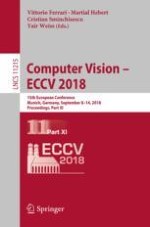2018 | OriginalPaper | Buchkapitel
Neural Network Encapsulation
verfasst von : Hongyang Li, Xiaoyang Guo, Bo Dai, Wanli Ouyang, Xiaogang Wang
Erschienen in: Computer Vision – ECCV 2018
Aktivieren Sie unsere intelligente Suche, um passende Fachinhalte oder Patente zu finden.
Wählen Sie Textabschnitte aus um mit Künstlicher Intelligenz passenden Patente zu finden. powered by
Markieren Sie Textabschnitte, um KI-gestützt weitere passende Inhalte zu finden. powered by
